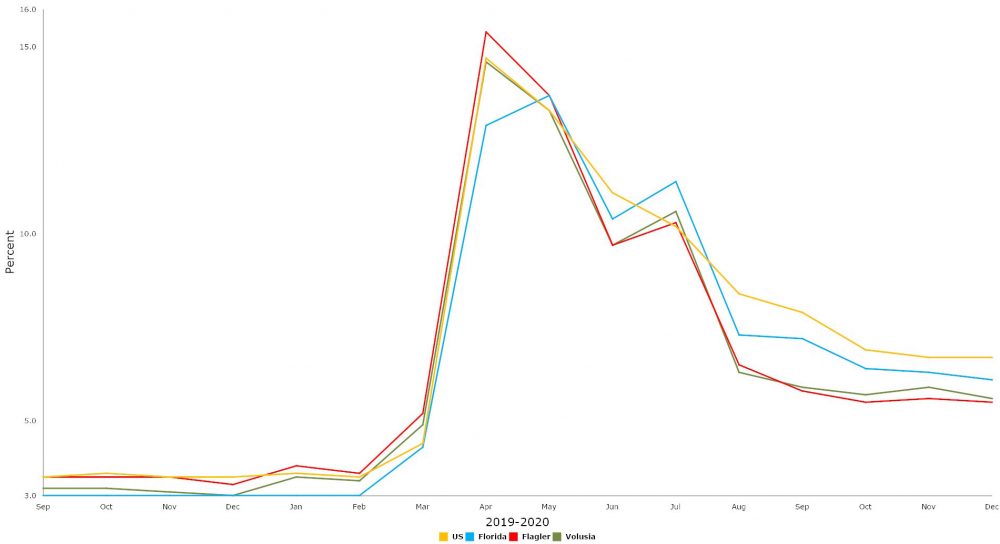
For the fourth month in a row Flagler County’s unemployment rate has remained within a narrow band of three decimal points, fluctuating between 5.8 and 5.5 percent, an almost insignificant difference when the figures are revised and the rates adjusted up or down by a few points, as they were for December, when Flagler’s rate came in at 5.5 percent. That’s one decimal point below the revised November figure of 5.6 percent.
Florida’s unemployment rate is not as flat, edging down from 7.2 to 6.1 percent in te past four months and in December adding 16,800 jobs. That would normally be a regular month’s healthy expansion to the job rolls, but in times of pandemic, the figure reflects still more difficulties than health in an economy struggling against covid’s effects.
There are still 614,000 Floridians on the official jobless rolls. The number significantly underestimates the actual number of unemployed because it does not include discouraged workers who have dropped out of the labor force, workers who are not following the state’s very stringent requirements to be counted among the unemployed–and receive unemployment checks–or the underemployed: those working part-time for economic reasons, because their hours were cut back or because they could not find the full-time work they need. If those unemployed were included, Florida’s unemployment and underemployment rate would be closer to 13 percent, more than double the state’s official rate, according to the federal Labor Department, which tabulates the so-called “Alternative measures of labor underutilization.” The nation’s rate, by that calculation, is 12.3 percent.
Florida officials typically boast of the state’s lower unemployment rate, compared to the nation’s. But that’s based on a somewhat deceptive accounting, especially in the covid economy, that ignored the underemployed in the state’s hospitality industry, the hardest-hit sector, whose ranks of unemployed and underemployed swell the state’s rate past the nation’s. Gov. Ron DeSantis today attributed the state’s better official rate to his policy of keeping as much of the state’s economy open as possible, including schools, despite the pandemic’s heavy toll.
“I think part of that is the fact that Florida is open, our schools are open,” he said in a Key Largo appearance today. “Parents have the ability to send their kids in person. People have a right to work in Florida. Government can’t shut you down. And businesses have a right to operate. And I think you’re seeing the results of that.” On jan. 17 the state’s seven-day average of daily deaths attributed to covid-19 was 175, approaching the peak set last summer. The count does not yet reflect the peak of covid cases recorded about two weeks after the Christmas and New Year holidays. So far 24,738 Floridians have died due to covid, including 60 in Flagler.
Florida’s service industry continues to be battered by the pandemic, falling over 400,000 jobs short of where it stood a year ago. Retail added 8,600 jobs in December but is 24,000 jobs below where it was a year ago. Leisure and hospitality, including restaurants and bars, lost more jobs in Dec ember (2,300), and remains almost 200,000 jobs short of where it was a year ago: consumers have been reluctant to frequent bars, restaurants and stores as they used to.
Though consumer confidence ticked up slightly in December, the University of Florida’s Bureau of Economic and Business Research reports that “consumer sentiment ends 2020 far below the levels recorded before the coronavirus pandemic.”
“The gain in December’s consumer sentiment reading comes from Floridians’ expectations about their personal finances a year from now and expectations about the economy in five years. However, the pessimism coming from consumers’ opinions about the national economic outlook in the next year suggests that Floridians anticipate gloomy economic prospects ahead in 2021,” said Hector H. Sandoval, director of the Economic Analysis Program at the bureau. “As the year ends, the difference between February and December is a remarkable 20.1-point gap, which can take a while to close. For instance, it took around four years to regain 20 points after consumer confidence collapsed during
the Great Recession.”
There will be a close correlation between the success (or failure) of vaccination efforts and consumer confidence, Sandoval suggested.
In Flagler, December’s figures show a labor force a little less than 1,000 below what it was a year ago, when it was near or at a record 47,000, with 43,600 Flagler residents holding jobs, almost 2,000 fewer than a year ago. The job-holders may be working in Flagler or any other county. There were 2,560 unemployed residents in Flagler, 1,000 more than a year ago. (Keeping in mind that those are the official unemployment figures, not those reflective of discouraged workers or of the under-employed.) Flagler had the 20th-highest unemployment rate out of Florida’s 67 counties. Tourism-heavy Osceola remains first, at 8.7 percent, followed by Miami-Dade (7.3) Orange and Putnam (7.2). St. Johns was tied with Wakulla County with the lowest unemployment rate, at 3.6 percent. A sizeable number of Flagler residents work in St. Johns.
![]()





























Leave a Reply